Keynote Speakers
Alison G. Power
Disease ecology in plant communities
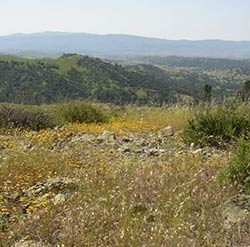 Despite the ubiquity and potential importance of pathogens in diverse plant communities, our understanding of how biodiversity governs disease spread in natural and agricultural communities is still rudimentary. Most disease research focuses on single pathogens infecting single hosts, but infections of a single host by multiple pathogens are common in nature, and pathogens with multiple host species are also widespread. Using an experimentally tractable system of annual grasses and generalist plant viruses, we have addressed the role of host diversity and pathogen diversity in shaping disease transmission and virulence. Field and lab experiments demonstrate striking feedbacks between host community structure and disease dynamics via pathogen-mediated competition, along with strong effects of pathogen diversity on disease spread and virulence.
Despite the ubiquity and potential importance of pathogens in diverse plant communities, our understanding of how biodiversity governs disease spread in natural and agricultural communities is still rudimentary. Most disease research focuses on single pathogens infecting single hosts, but infections of a single host by multiple pathogens are common in nature, and pathogens with multiple host species are also widespread. Using an experimentally tractable system of annual grasses and generalist plant viruses, we have addressed the role of host diversity and pathogen diversity in shaping disease transmission and virulence. Field and lab experiments demonstrate striking feedbacks between host community structure and disease dynamics via pathogen-mediated competition, along with strong effects of pathogen diversity on disease spread and virulence.
Andrew F. Read
Pathogen evolution in the Anthropocene
 Evolution is one of the leading challenges for 21st century medicine and public health. Cancers, pathogens and disease-transmitting organisms like mosquitoes rapidly evolve in response to medical and public health interventions. This adaptive evolution can erode the efficacy of initially effective technologies like drugs, vaccines, and insecticides. Managing evolution (and equally, avoiding evolutionary mismanagement) requires a quantitative understanding of the competing ecological forces shaping this adaptation, not least those forces imposed by medical practice. I will argue that ‘adaptation science’ offers the prospect of rational evolutionary management and can suggest new ways to evolution-proof health care technologies.
Evolution is one of the leading challenges for 21st century medicine and public health. Cancers, pathogens and disease-transmitting organisms like mosquitoes rapidly evolve in response to medical and public health interventions. This adaptive evolution can erode the efficacy of initially effective technologies like drugs, vaccines, and insecticides. Managing evolution (and equally, avoiding evolutionary mismanagement) requires a quantitative understanding of the competing ecological forces shaping this adaptation, not least those forces imposed by medical practice. I will argue that ‘adaptation science’ offers the prospect of rational evolutionary management and can suggest new ways to evolution-proof health care technologies.
Photo credit: Electron micrographs of infected mosquito midguts by John Findlay, Electron Microscopy, Daniel Rutherford Building, University of Edinburgh, Scotland, UK.
Presenters
Cayelan C. Carey
Synergistic interactions between eutrophication and climate change: implications for water quality in lakes
 As a result of climate change, eutrophication, unsustainable withdrawal, and the introduction of invasive species, humans are altering ecosystem functioning in freshwater lakes around the globe at an unprecedented rate. While many studies have examined the effects of these stressors on water quality in isolation, less is known about how they will interact. By integrating a diverse dataset of long-term monitoring records, lake surveys, and mesocosm experiments, I highlight how anthropogenic stressors can interact in context-dependent – and sometimes surprising – ways to alter plankton food webs and nutrient cycling. For example, I found that increasing water temperatures and eutrophication can synergistically interact to promote the growth of toxic cyanobacterial blooms, but that the synergism is dependent on lake trophic state. Moreover, under some scenarios, increased nutrients and temperatures may counteract, thereby nullifying their effects. In sum, my research demonstrates that lake responses to multiple human drivers are nuanced and complex, and will have substantial implications not only for aquatic community and ecosystem dynamics, but also for the future management of our water resources.
As a result of climate change, eutrophication, unsustainable withdrawal, and the introduction of invasive species, humans are altering ecosystem functioning in freshwater lakes around the globe at an unprecedented rate. While many studies have examined the effects of these stressors on water quality in isolation, less is known about how they will interact. By integrating a diverse dataset of long-term monitoring records, lake surveys, and mesocosm experiments, I highlight how anthropogenic stressors can interact in context-dependent – and sometimes surprising – ways to alter plankton food webs and nutrient cycling. For example, I found that increasing water temperatures and eutrophication can synergistically interact to promote the growth of toxic cyanobacterial blooms, but that the synergism is dependent on lake trophic state. Moreover, under some scenarios, increased nutrients and temperatures may counteract, thereby nullifying their effects. In sum, my research demonstrates that lake responses to multiple human drivers are nuanced and complex, and will have substantial implications not only for aquatic community and ecosystem dynamics, but also for the future management of our water resources.
Photo credit: Lake Windemere by Louise Miles
Amy M. Iler
Climate-induced shifts in flowering phenology: demographic consequences and community-level responses
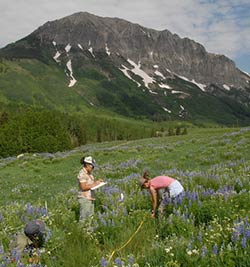 Climate-induced shifts in flowering phenology: demographic consEarlier phenology – the timing of biological events – is a hallmark of anthropogenic climate change in temperate regions across the globe. This is important because phenology is intimately tied to the reproduction and survival of organisms. Despite this, demographic consequences are rarely linked to phenological change, and it is unclear how species-level phenological change scales up to the community-level. To address these knowledge gaps, I utilize two long-term plant datasets from the Colorado Rocky Mountains. Demographic modeling reveals that climate change may lead to increased growth in a focal plant species via longer growing seasons, decreased reproduction via frost damage to developing flower buds in early-flowering years, and an overall population decline. At the community level, a diversity of species-level shifts in the timing of first, peak, and last flowering lead to altered patterns of co-flowering (temporal overlap) for pairs of species within the community and a redistribution of floral resources across an expanded flowering season. This research sheds light on mechanisms by which climate-induced shifts in phenology can affect population dynamics and reshape ecological communities, highlighting the value of combining long-term observational studies with modeling approaches.equences and community-level responses
Climate-induced shifts in flowering phenology: demographic consEarlier phenology – the timing of biological events – is a hallmark of anthropogenic climate change in temperate regions across the globe. This is important because phenology is intimately tied to the reproduction and survival of organisms. Despite this, demographic consequences are rarely linked to phenological change, and it is unclear how species-level phenological change scales up to the community-level. To address these knowledge gaps, I utilize two long-term plant datasets from the Colorado Rocky Mountains. Demographic modeling reveals that climate change may lead to increased growth in a focal plant species via longer growing seasons, decreased reproduction via frost damage to developing flower buds in early-flowering years, and an overall population decline. At the community level, a diversity of species-level shifts in the timing of first, peak, and last flowering lead to altered patterns of co-flowering (temporal overlap) for pairs of species within the community and a redistribution of floral resources across an expanded flowering season. This research sheds light on mechanisms by which climate-induced shifts in phenology can affect population dynamics and reshape ecological communities, highlighting the value of combining long-term observational studies with modeling approaches.equences and community-level responses
Photo credit: Delphinium field survey by Daniel Inouye
Daniel Sol Karp
Harmonizing biodiversity conservation and food production across tropical countryside
 A critical challenge for the next century will be transitioning towards food systems that conserve biodiversity, sustain life-support systems, and secure rural livelihoods. Worldwide, however, intensive monocultures are replacing natural areas and the diversified farms that traditionally cultivated multiple crops and maintained native vegetation. I compared bird biodiversity and biodiversity-driven ecosystem services between forest reserves, diversified farms, and intensive monocultures across Costa Rica. Communities in intensive monocultures were depauperate, similar between distant eco-regions, and dominated by closely related species from young clades. In contrast, forest reserves and diversified farms hosted species rich and phylogenetically diverse communities. These diverse communities also benefited farmers. Birds halved infestations of coffee’s most damaging insect pest, the coffee berry borer beetle (Hypothenemus hampei) and prevented US$70-US$310/ha in damage, a gain per farm on par with the average income of a Costa Rican citizen. I also found that conserving forest patches on farmland would likely increase pest control. Both borer predators (identified through assaying feces for borer DNA) and predation rates increased near forest patches. These results suggest that conserving rainforest in farmland, or diversifying farms more broadly, represents a promising win-win opportunity for biodiversity and farmers.
A critical challenge for the next century will be transitioning towards food systems that conserve biodiversity, sustain life-support systems, and secure rural livelihoods. Worldwide, however, intensive monocultures are replacing natural areas and the diversified farms that traditionally cultivated multiple crops and maintained native vegetation. I compared bird biodiversity and biodiversity-driven ecosystem services between forest reserves, diversified farms, and intensive monocultures across Costa Rica. Communities in intensive monocultures were depauperate, similar between distant eco-regions, and dominated by closely related species from young clades. In contrast, forest reserves and diversified farms hosted species rich and phylogenetically diverse communities. These diverse communities also benefited farmers. Birds halved infestations of coffee’s most damaging insect pest, the coffee berry borer beetle (Hypothenemus hampei) and prevented US$70-US$310/ha in damage, a gain per farm on par with the average income of a Costa Rican citizen. I also found that conserving forest patches on farmland would likely increase pest control. Both borer predators (identified through assaying feces for borer DNA) and predation rates increased near forest patches. These results suggest that conserving rainforest in farmland, or diversifying farms more broadly, represents a promising win-win opportunity for biodiversity and farmers.
Mike Martin
Using ancient DNA from historical herbarium collections to tell two stories of human influences on New World plant evolution
 Plant and pathogen evolution is altered by large-scale human activity. Genetic material from historical herbarium samples provides a powerful tool for investigation of these processes. My studies of two New World natives that were changed by human activity show that they now influence our lives in unforeseen ways.
Plant and pathogen evolution is altered by large-scale human activity. Genetic material from historical herbarium samples provides a powerful tool for investigation of these processes. My studies of two New World natives that were changed by human activity show that they now influence our lives in unforeseen ways.
- Accidentally exported to Europe in potato shipments, the plant pathogen. Phytophthora infestans triggered the Irish potato famine of 1845-49 and continues to beleaguer global potato farming. By sequencing the genome of the fungus-like pathogen from an infected potato plant collected in 1845 and preserved for 168 years, I showed that—likely as a result of potato breeding in response to the devastation of the Great Famine—the pathogen has become more virulent over time.
- Ragweed is a globally invasive weed known for its highly allergenic pollen. However, sedimentary records show this species was pre-‐historically uncommon, and populations expanded only after European colonists’ rapid conversion of forests to agricultural fields. Genotyping hundreds of 19th-century specimens revealed that ragweed’s genetic structure mirrored patterns of agricultural expansion across the landscape, and genotypes associated with agriculture are a likely source of modern Europe’s aggressive invasive populations.
Sophie Julia McCoy
Effects of ocean acidification on macroalgal communities
 Anthropogenic carbon emissions influence marine systems primarily in two ways, by fuelling temperature changes in many parts of the oceans and by changing seawater carbon chemistry, which lowers seawater pH and drives the process of ocean acidification. Macroalgae are major players in coastal carbon cycling at temperate latitudes where there exists high algal biodiversity and biomass, and also in the tropics where coralline algae are important to reef carbon dynamics. As primary producers that also have calcium carbonate skeletons, corallines are expected to have mixed responses to ocean acidification. Increased inorganic carbon availability in seawater may boost photosynthesis, while reduced carbonate concentrations may negatively affect skeletal mineralization and growth.
Anthropogenic carbon emissions influence marine systems primarily in two ways, by fuelling temperature changes in many parts of the oceans and by changing seawater carbon chemistry, which lowers seawater pH and drives the process of ocean acidification. Macroalgae are major players in coastal carbon cycling at temperate latitudes where there exists high algal biodiversity and biomass, and also in the tropics where coralline algae are important to reef carbon dynamics. As primary producers that also have calcium carbonate skeletons, corallines are expected to have mixed responses to ocean acidification. Increased inorganic carbon availability in seawater may boost photosynthesis, while reduced carbonate concentrations may negatively affect skeletal mineralization and growth.
Historical baselines in a coastal community of coralline algae provide context for ecological changes since the onset of acidification in the Northeast Pacific. Changes in tissue production have led to shifts in historical baselines and competitive hierarchies, which corroborate observed changes in local species abundances and point to a pervasive change in the populations of some coralline algal species in this region. Finally, experimental interaction and demographic data was used to parameterize a cellular automaton model that predicts species richness and biodiversity under past, current, and future conditions.
Emily Jane McTavish
From the Aurochs to the Anthropocene – domestication and global movement of cattle in the past 10,000 years
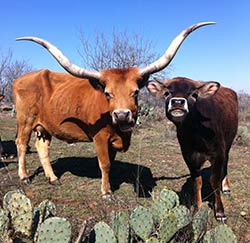 Cattle were domesticated from their wild ancestor, the aurochs (Bos primigenius) in at least two regions of the world approximately 10,000 years ago. Since then, people and cattle have impacted not only one another’s evolution, but also the ecology and evolution of other species around the world. In many regions cattle have replaced endemic species, such as bison, as peak grazers. The two subspecies of domesticated cattle (Bos indicus and Bos taurus) captured deep divergence within the aurochs, comprising lineages sharing a most recent common ancestor 200,000 or more years ago. As peoples moved across the world bringing livestock with them, these divergent lineages have hybridized in several different regions, generating novel combinations of genetic material that would not have occurred in the wild. We used 55,000 genetic markers to track the global population structure of cattle and to capture regions of ancestry descended from each of these ancestral lineages in groups derived from hybridization as long as 4,000 years ago and as recently as the 1950s. By studying the global movement and ancestry of cattle we can better understand how human activities have driven changes in ecological and evolutionary processes worldwide.
Cattle were domesticated from their wild ancestor, the aurochs (Bos primigenius) in at least two regions of the world approximately 10,000 years ago. Since then, people and cattle have impacted not only one another’s evolution, but also the ecology and evolution of other species around the world. In many regions cattle have replaced endemic species, such as bison, as peak grazers. The two subspecies of domesticated cattle (Bos indicus and Bos taurus) captured deep divergence within the aurochs, comprising lineages sharing a most recent common ancestor 200,000 or more years ago. As peoples moved across the world bringing livestock with them, these divergent lineages have hybridized in several different regions, generating novel combinations of genetic material that would not have occurred in the wild. We used 55,000 genetic markers to track the global population structure of cattle and to capture regions of ancestry descended from each of these ancestral lineages in groups derived from hybridization as long as 4,000 years ago and as recently as the 1950s. By studying the global movement and ancestry of cattle we can better understand how human activities have driven changes in ecological and evolutionary processes worldwide.
Rebecca C. Terry
Holocene fossils and historical resurveys: evaluating ecosystem-level restructuring of Great Basin small mammal communities due to anthropogenic environmental change
 Efforts to understand the ecological impacts of environmental change have predominantly focused on the species-‐level, leaving less known about the responses of aggregate community-‐ and ecosystem-‐level properties. It is often assumed, for example, that properties such as richness, biomass, and energy flux are relatively robust to environmental change due to compensatory dynamics of the underlying species. However, many ecological processes unfold over time-‐scales inaccessible to direct observation or experimentation. Here I examine how the aggregate properties of Great Basin small mammals responded to climate change and habitat transformation over both historical and paleontological time-‐scales. I do so using the Holocene fossil record as a climate-‐driven baseline against which to contrast responses seen over the past century. These analyses reveal significant restructuring of the aggregate properties across two important environmental transitions in the early to middle Holocene and in the last 200 years. The latter transition is marked by dramatic shifts away from baseline conditions revealing how modern-‐day land-‐use practices are modifying climate-‐only expectatations. These results illustrate how integrating across ecological and temporal scales can provide powerful insights into faunal response, and can inform long-‐term conservation and management efforts.
Efforts to understand the ecological impacts of environmental change have predominantly focused on the species-‐level, leaving less known about the responses of aggregate community-‐ and ecosystem-‐level properties. It is often assumed, for example, that properties such as richness, biomass, and energy flux are relatively robust to environmental change due to compensatory dynamics of the underlying species. However, many ecological processes unfold over time-‐scales inaccessible to direct observation or experimentation. Here I examine how the aggregate properties of Great Basin small mammals responded to climate change and habitat transformation over both historical and paleontological time-‐scales. I do so using the Holocene fossil record as a climate-‐driven baseline against which to contrast responses seen over the past century. These analyses reveal significant restructuring of the aggregate properties across two important environmental transitions in the early to middle Holocene and in the last 200 years. The latter transition is marked by dramatic shifts away from baseline conditions revealing how modern-‐day land-‐use practices are modifying climate-‐only expectatations. These results illustrate how integrating across ecological and temporal scales can provide powerful insights into faunal response, and can inform long-‐term conservation and management efforts.
Photo credit:Tiny fossils by Rick Eagan, Salt Lake City Tribune
Keynote Speakers
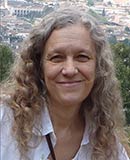
Allison G. Power
Professor, Department of Ecology and Evolutionary Biology, Cornell University
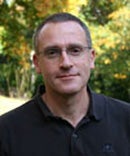
Andrew F. Read
Alumni Professor in the Biological Sciences and Professor of Entomology, Eberly College of Science Distinguished Senior Scholar, Director, Center for Infectious Disease Dynamics, Penn State University
Pathogen evolution in the Anthropocene
Presenters
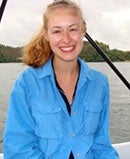
Cayelan C. Carey
Assistant Professor, Department of Biological Sciences, Virginia Tech
Synergistic interactions between eutrophication and climate change: implications for water quality in lakes

Amy M. Iler
Postdoctoral Research Associate, Rocky Mountain Biological Laboratory, University of Maryland
Climate-induced shifts in flowering phenology: demographic consequences and community-level responses
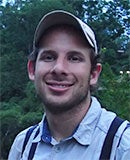
Daniel Sol Karp
NatureNet Science Fellow, The Nature Conservancy and University of California at Berkeley
Harmonizing biodiversity conservation and food production across tropical countryside
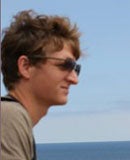
Mike Martin
Postdoctoral Researcher, Centre for GeoGenetics, Natural History Museum of Denmark, University of Copenhagen
Using ancient DNA from historical herbarium collections to tell two stories of human influences on New World plant evolution

Sophie Julia McCoy
Graduate student, Department of Ecology and Evolution, The University of Chicago
Effects of ocean acidification on macroalgal communities

Emily Jane McTavish
Postdoctoral Researcher, Department of Ecology and Evolutionary Biology, University of Kansas
From the Aurochs to the Anthropocene – domestication and global movement of cattle in the past 10,000 years
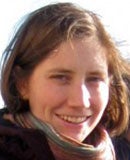
Rebecca C. Terry
Assistant Professor, Department of Zoology, Oregon State University
Holocene fossils and historical resurveys: evaluating ecosystem-level restructuring of Great Basin small mammal communities due to anthropogenic environmental change


